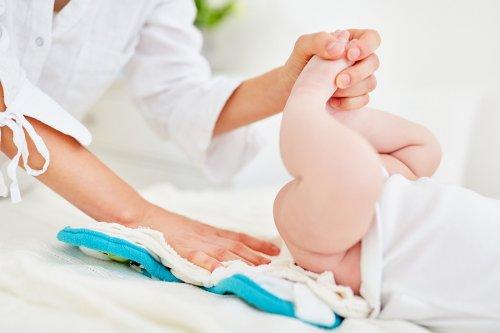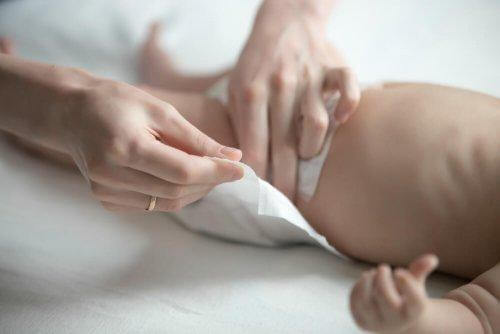Learn How to Properly Change a Diaper, Step by Step

To learn how to properly change a diaper, these helpful tips will come in handy. During your newborn’s first weeks of life, you’ll have the opportunity to practice quite a lot, as you’ll have to change his or her diaper constantly to ensure good hygiene and prevent skin conditions.
How to properly change a diaper, step by step
Before you start changing your baby’s diaper, you have to have everything you need at hand. Always remember that it isn’t advisable to leave your baby alone, especially not in a crib.
You must have a disposable diaper or cloth diaper, as well as soap, water, and a towel. It’s also good to have protective cream and baby wipes if you’re not at home.
Enable a safe and comfortable area near a sink, or at least have a small bucket of soap water nearby, as you should wash the urine and feces whenever possible.
After that, place your baby on the changing table and take off his clothes from the waist down. Then, pull up the dirty diaper’s sticky tabs. Lift your baby’s legs. If there are feces, drag the diaper all the way to the back.
After that, wash your child with soap and water. If this isn’t possible, use baby wipes to clean the genital area. This way, you’ll avoid infection.
Finally, gently dry the area with a towel. Make sure your baby’s skin is dry and free of moisture. It’s advisable to apply protective cream around the crotch and buttocks. Make sure to spread it properly and not over-apply.
How to put on a clean diaper
Learning to put on a diaper properly is one of the most important steps. The first thing to do is open the diaper and place it under your baby’s bottom.
Then, bring the front up over the baby’s stomach. If you have a boy, make sure the diaper hangs a bit so it can retain urine.

The front and back should be at the same height. To ensure this, open the sticky tabs in the back of the diaper.
Then, fasten them properly in the front. Make sure the diaper isn’t too tight nor too loose. This is essential to reduce the risk of leaks.
Tips for changing your baby’s diaper
If you’re in the process of learning how to properly change a diaper, these tips will be helpful.
First, you must thoroughly clean the vulva and foreskin if there is stool. In addition, you shouldn’t use baby wipes frequently because they cause allergies and rashes in some children due to their components and pH, which are unsuitable for them.
Also, alternate between cloth and disposable diapers when you’re at home and use cloth ones during the summer. These allow for better movement and let the skin breathe. In addition, they’re lighter.
Moreover, the constant use of disposable diapers causes alterations in the baby’s skin because it hinders transpiration.
“Before you start changing your baby’s diaper, you have to have everything you need at hand. Always remember that it isn’t advisable to leave your baby alone, especially not in a crib.”
Other suggestions are putting on clothes that will be easy to remove when the time comes to change diapers and avoid one-piece garments. This way, you’ll save time and ensure your baby is always comfortable.
You shouldn’t use safety pins to fasten cloth diapers. Today, there are diapers with self-adhesive tabs just like disposable diapers.
On the other hand, you must change babies’ diapers frequently – after they poop, after you feed them, and when they wake up after a nap. It’s important to wash your hands before and after each diaper change to avoid spreading bacteria or an infection.
Causes of diaper-related skin conditions

The most common are skin irritations caused by urine and stool, which cause diaper rash. Other causes are attributed to chafing or rubbing that lead to rashes due to tight diapers or clothes.
Another factor is the use of new products, such as a different brand of baby wipes, diapers, detergents, or fabric softeners. These can cause rashes and redness, especially in the area where you put on the diaper.
It’s worth mentioning that these conditions must be treated quickly, as they can spread fungi and bacteria that cause serious infections.
In conclusion, you no longer have to worry if you don’t know how to properly change a diaper. With these suggestions, you’ll care for your baby very well.
To learn how to properly change a diaper, these helpful tips will come in handy. During your newborn’s first weeks of life, you’ll have the opportunity to practice quite a lot, as you’ll have to change his or her diaper constantly to ensure good hygiene and prevent skin conditions.
How to properly change a diaper, step by step
Before you start changing your baby’s diaper, you have to have everything you need at hand. Always remember that it isn’t advisable to leave your baby alone, especially not in a crib.
You must have a disposable diaper or cloth diaper, as well as soap, water, and a towel. It’s also good to have protective cream and baby wipes if you’re not at home.
Enable a safe and comfortable area near a sink, or at least have a small bucket of soap water nearby, as you should wash the urine and feces whenever possible.
After that, place your baby on the changing table and take off his clothes from the waist down. Then, pull up the dirty diaper’s sticky tabs. Lift your baby’s legs. If there are feces, drag the diaper all the way to the back.
After that, wash your child with soap and water. If this isn’t possible, use baby wipes to clean the genital area. This way, you’ll avoid infection.
Finally, gently dry the area with a towel. Make sure your baby’s skin is dry and free of moisture. It’s advisable to apply protective cream around the crotch and buttocks. Make sure to spread it properly and not over-apply.
How to put on a clean diaper
Learning to put on a diaper properly is one of the most important steps. The first thing to do is open the diaper and place it under your baby’s bottom.
Then, bring the front up over the baby’s stomach. If you have a boy, make sure the diaper hangs a bit so it can retain urine.

The front and back should be at the same height. To ensure this, open the sticky tabs in the back of the diaper.
Then, fasten them properly in the front. Make sure the diaper isn’t too tight nor too loose. This is essential to reduce the risk of leaks.
Tips for changing your baby’s diaper
If you’re in the process of learning how to properly change a diaper, these tips will be helpful.
First, you must thoroughly clean the vulva and foreskin if there is stool. In addition, you shouldn’t use baby wipes frequently because they cause allergies and rashes in some children due to their components and pH, which are unsuitable for them.
Also, alternate between cloth and disposable diapers when you’re at home and use cloth ones during the summer. These allow for better movement and let the skin breathe. In addition, they’re lighter.
Moreover, the constant use of disposable diapers causes alterations in the baby’s skin because it hinders transpiration.
“Before you start changing your baby’s diaper, you have to have everything you need at hand. Always remember that it isn’t advisable to leave your baby alone, especially not in a crib.”
Other suggestions are putting on clothes that will be easy to remove when the time comes to change diapers and avoid one-piece garments. This way, you’ll save time and ensure your baby is always comfortable.
You shouldn’t use safety pins to fasten cloth diapers. Today, there are diapers with self-adhesive tabs just like disposable diapers.
On the other hand, you must change babies’ diapers frequently – after they poop, after you feed them, and when they wake up after a nap. It’s important to wash your hands before and after each diaper change to avoid spreading bacteria or an infection.
Causes of diaper-related skin conditions

The most common are skin irritations caused by urine and stool, which cause diaper rash. Other causes are attributed to chafing or rubbing that lead to rashes due to tight diapers or clothes.
Another factor is the use of new products, such as a different brand of baby wipes, diapers, detergents, or fabric softeners. These can cause rashes and redness, especially in the area where you put on the diaper.
It’s worth mentioning that these conditions must be treated quickly, as they can spread fungi and bacteria that cause serious infections.
In conclusion, you no longer have to worry if you don’t know how to properly change a diaper. With these suggestions, you’ll care for your baby very well.
This text is provided for informational purposes only and does not replace consultation with a professional. If in doubt, consult your specialist.








